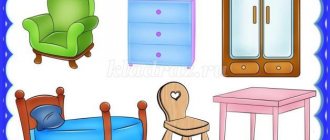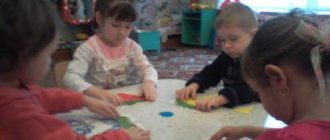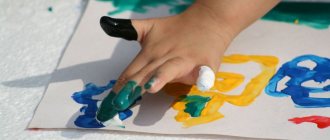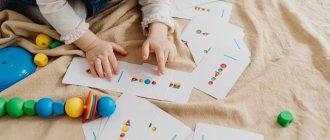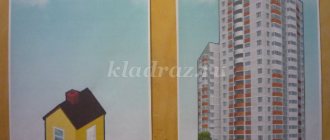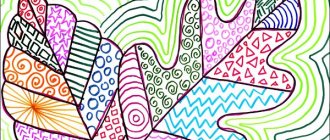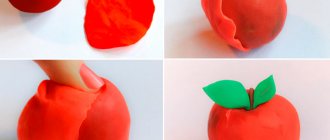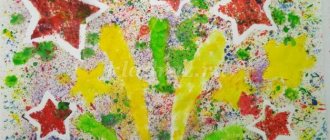Summary of the lesson on FCCM in the first junior group “In a forest clearing”
Goal: to teach children to draw a spring flower in an unconventional way.
Tasks:
• Continue learning to draw with a sponge on a piece of paper;
• Learning to draw flowers using the “dipping”
• develop imagination and perception of the surrounding world, develop fine motor skills;
• Consolidate knowledge of colors (yellow, red, blue);
• cultivate a caring attitude towards nature, form an emotionally positive attitude towards the drawing process itself.
Equipment and materials: Musical recordings (bird voices, murmur of a stream, buzzing of a bee), soft toy: Maya the bee, sponge, yellow gouache, flower meadow, pictures of dandelion
Preliminary work: reading books, memorizing poems, looking at paintings “Flowers in Spring”
, conversation about spring, observing changes in nature in spring, looking at insects.
Progress of the lesson:
Children sit around the teacher, a melody with the sounds of spring sounds.
Educator: Guys, let's listen to what beautiful music it sounds. What did you hear?
Children's answers.
Educator: What time of year do you think we can hear these sounds?
Children's answers.
Educator: That's right, we can hear all these sounds in the spring.
Educator: Guys, what happens in nature in the spring?
Children: Everything is waking up. With the arrival of spring, the sun began to shine brighter, it warms us very much.
Educator: At this time, insects appear. Do you know where they live (in the forest, in the city, in the park)
I invite you today to a forest clearing to visit insects.
Do you agree? Went!
Educator: We went out to the forest clearing, raising our legs higher.
Through bushes and hummocks, through branches and stumps.
Who walked so deftly without tripping or falling?
They approach the model of the clearing, covered with a green tablecloth with flowers.
Educator: Well, here we are! Look what a beautiful clearing! What do you see on it (flowers)
Name what color they are (red, yellow, blue, etc.) Let's sit down in the flower meadow, relax a little, admire the flowers.
Educator: Oh, children, do you hear? Who's buzzing?)…
Children: Bee.
Educator: Hello, bee!
Maya the Bee: Hello guys. My name is Maya the Bee! I got into trouble. Soon my bee friends will come to visit me; they really love flower nectar from dandelions. But I have nothing to treat them with, because there are still very few dandelions in our clearing. And I really want to collect a lot of nectar and treat my friends. Maybe you can help me?
- Children, where can we get dandelions?
- Yes, guys, I also think that we can draw dandelions.
But first let's play
PHYSMINUTE
Imagine that you are dandelions and growing in this clearing ( Children squat)
— Dandelions are starting to grow. Grow, grow - grown!
The wind blew and the dandelions swayed.
Evening has come, the dandelions are closing.
Morning has come - the dandelions have woken up and are nodding their heads.
Educator: Have you rested?! Now let’s all sit down at the table and look at the picture of a dandelion. What dandelion?
Children: Beautiful, yellow, round.
Educator: What are flowers for?
Children: To admire them.
—What does a dandelion flower look like? (in the sun, on the ball).
Educator: Today we will draw with a sponge.
“I’ll show you now how we’ll draw flowers using a sponge.” Dandelion, what color?
Children: Yellow.
— We dip the sponge in yellow paint, then “dip it in”
on the green grass. You get beautiful yellow dandelions.
The colors suddenly became like flowers, Lighting up everything around!
In the new yellow sundress Dandelion Meadow.
- Well done guys, you tried really hard
What wonderful flowers they turned out to be. Now let's place the dandelions together in our clearing - it turned out very beautiful. We will get a large dandelion meadow. - Guys, what do you think, is it possible to pick flowers just like that? Trample them underfoot? On green grass, yellow dandelions are very beautiful. Although there are a lot of them, you shouldn’t pick them.
Let's not pick dandelions and preserve beauty. And the bees will thank us for saving the flowers for them.
Oh, here our bee has arrived! That's how great!
-Bee: Oh, thank you, guys! Like there are many flowers in the meadow, I will now collect a lot of delicious nectar and treat it to my friends.
Subject:
"In a forest clearing"
Goal: to teach children to draw a spring flower in an unconventional way.
During the lesson it was expected to solve the following problems
Tasks:
• Continue learning to draw with a sponge on a piece of paper;
• Learning to draw flowers using the “dipping”
• develop imagination and perception of the surrounding world, develop fine motor skills;
• Strengthen knowledge of colors (yellow, red, blue);
• cultivate a caring attitude towards nature, form an emotionally positive attitude towards the drawing process itself
When developing this lesson summary, I first of all took into account the age and mental individual characteristics of the children of the first junior group.
Preliminary work was carried out with the children: reading books, memorizing poems, looking at the paintings “Flowers in Spring”
, conversation about spring, observing changes in nature in spring, looking at insects.
During the lesson, the children were active - they participated in the game and answered questions.
The children's interest remained throughout the lesson. The children were attentive
I believe that I was able to fully implement the assigned tasks.
Organization of a developing subject-spatial environment in groups of primary preschool age
“Organization of a developing subject-spatial environment in groups of primary preschool age”
Prepared by Mullakhmetova A.K.
To improve the quality of educational services and build an effective pedagogical process in a modern preschool institution, it is fundamentally important to understand the capabilities of the subject-spatial environment, knowledge of regulatory requirements and approaches to its design.
Content
a developing subject-spatial environment helps children satisfy their interests, reveal their potential, and establish themselves as a creatively capable personality. In a preschool institution, the content of the developing subject-spatial environment and its content are distinguished by the individuality and creative approach of teachers.
Under the developing subject-spatial environment
one should understand a natural comfortable environment, rationally organized in space and time, saturated with a variety of objects and play materials. In such an environment, it is possible to simultaneously involve all children in the group in active cognitive and creative activities.
The developmental environment acts as a stimulator, a driving force in the holistic process of developing a child’s personality; it enriches his development, promotes the early manifestation of versatile abilities, and inclusion in active cognitive and creative activities. The subject-game environment is organized in such a way that every student has the opportunity to do what they love.
The developing subject-spatial environment of the group should contain:
rich,
transformable,
multifunctional,
variable,
accessible,
safe.
When creating a subject-development environment, you must remember:
1. The environment must perform educational, developmental, nurturing, stimulating, organized, communicative functions. But the most important thing is that it should work to develop the child’s independence and initiative.
2. Flexible and variable use of space is necessary. The environment should serve to meet the needs and interests of the child.
3. The shape and design of items is focused on the safety and age of children.
4. Decorative elements should be easily replaceable.
5. In each group it is necessary to provide a place for children's experimental activities.
6. When organizing the subject environment in a group room, it is necessary to take into account the patterns of mental development, indicators of their health, psychophysiological and communicative characteristics, the level of general and speech development, as well as indicators of the emotional and need sphere.
7. The color palette should be represented by warm, pastel colors.
8. When creating a developmental space in a group room, it is necessary to take into account the leading role of play activities.
9. The subject-developmental environment of the group should change depending on the age characteristics of the children, the period of study, and the educational program.
RPP environment in early preschool age
•For children of this age, a sufficiently large space in the group is necessary to satisfy the need for physical activity. A properly organized developmental environment allows every child to find something they like, to believe in their strengths and abilities, to learn to interact with teachers and peers, to understand and evaluate their feelings and actions, and this is precisely what lies at the heart of developmental education.
•When creating a developmental space in a group room, it is necessary to take into account the leading role of play activity in development, this in turn will ensure the emotional well-being of each child, the development of his positive sense of self, competence in the field of relationships with the world, with people, with himself, and inclusion in various forms of cooperation , which are the main goals of preschool education and upbringing
Junior group
The environment in the younger group is primarily created as comfortable and safe for the child. Young children do not respond well to spatial changes in their environment; they prefer stability in this regard.
Young children are first and foremost “doers.” The experience of active, varied activities is the most important condition for their development. A child’s stay in kindergarten is organized so that everyone has the opportunity to participate in a variety of activities: games, motor exercises, activities to examine the properties and qualities of objects, drawing, modeling, basic labor, and creative activities. In joint activities with the child, the teacher helps to master new ways and techniques of action, provides a model of behavior and attitude. Taking this into account, the spatial environment is organized for the simultaneous activities of 2-3 children and an adult.
Younger children actively develop movements, including walking, running, and climbing. At the same time, the movements are still poorly coordinated, there is no dexterity, speed of reaction, or evasiveness. Therefore, when organizing the spatial environment, it is advisable to place the equipment around the perimeter of the group, highlighting the play area and a place for household needs, and provide sufficiently wide, clearly visible paths of movement for the child. It is not recommended to include a lot of equipment in the setting; approximately two-thirds of the space should be free.
The subject environment of the group is organized in such a way as to stimulate children’s perception, promote the development of analyzers, and “suggest” methods of examination and action. Items are selected in pure colors, clear, simple shapes, different sizes, made from a variety of materials (but safe for the child’s health). It’s good if you can extract sounds from objects, feel aroma, smell, know the nature of the surface (smoothness, roughness), transparency, hardness-softness and other various properties.
To develop fine motor skills, in addition to special didactic toys: inserts, pyramids, lacing, you need to include plastic containers with lids of different shapes and sizes, boxes, and other household items that have gone out of use. By trying on lids to boxes, the child gains experience in comparing sizes, shapes, and colors.
In the group for four-year-old children, we use toys that reflect real life (for example, an ambulance, a truck, a car, a doctor doll, etc.). A number of game attributes need to be replaced with substitute objects to develop the child’s imagination and expand the creative possibilities of play.
Young children prefer large play equipment. It is necessary to place materials on open shelves, and the materials themselves are selected to be visually attractive, bright, and they need to be changed quite often (at least once a week). All toys and aids in the group must be accessible to the child, this contributes to the development of his activity and independence.
Many opportunities for children's development lie in play-experimentation. Games with sand, water, clay, paints require special equipment; this equipment can be purchased or made with your own hands; today our teachers will tell you about this in detail and show you during master classes. Among didactic games, games like lotto and paired pictures are preferred. There should also be mosaics (large plastic, magnetic and large nail), puzzles of 3-15 pieces, sets of cubes of 4-12 pieces, educational games (for example, “Fold the pattern”, “Fold the square”), as well as games with elements modeling and substitution. A variety of “soft constructors” on a carpet base allow you to organize the game in different ways: sitting at the table, standing against the wall, lying on the floor.
A young child begins to show an increasingly active interest in drawing. To gain experience in visual arts, it is best to have special self-erasing or wax boards with a drawing stick or a roll of simple white wallpaper and wax crayons (they do not stain your hands and do not crumble). The wallpaper is fixed on a wall covered with film or on a table and rewound as it is used. Kids love to draw with their palms; for such drawing it is better to use gouache with the addition of liquid soap or special paints.
It is very useful in a group to have many mirrors in different places, since the baby will be able to see himself among other children, observe his movements, facial expressions, and appearance. And the mummers corner will allow him to change his appearance and observe these changes, getting to know himself, so familiar and unfamiliar at the same time.
The content of a developing subject-spatial environment helps children satisfy their interests, reveal their potential, and establish themselves as a creatively capable personality. In a preschool institution, the content of the developing subject-spatial environment and its content are distinguished by the individuality and creative approach of teachers.
Conclusion.
Rich subject-developmental and educational environment
becomes the basis for organizing an exciting, meaningful life
and comprehensive development of each child. Developmental subject
the environment is the main means of shaping the child’s personality and
is the source of his knowledge and social experience.
The practice of working in kindergarten proves that it is correct
an organized developmental environment allows every child to find
something you enjoy, believe in your strengths and abilities, learn
interact with teachers and peers, understand and evaluate them
feelings and actions, and this is precisely what underlies the developing
communication. Free activities for children in development centers help them
independently carry out searches included in the research process, and
do not receive ready-made knowledge from the teacher.
